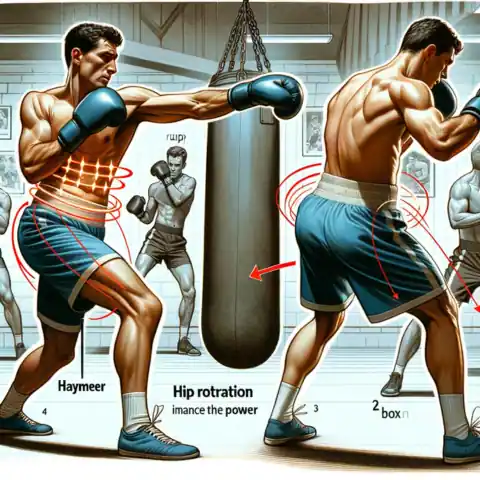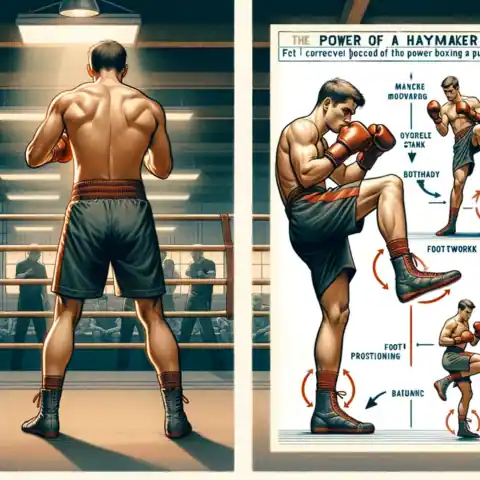Throwing a haymaker in boxing with high power is an art that combines strategy, timing, and full-body coordination. Start by distracting your opponent with a series of jabs and crosses, subtly setting them up for the big hit. This approach is like a magician’s misdirection, drawing their attention away from your real plan.
The perfect moment for a haymaker is when your opponent shows signs of fatigue, overconfidence, or distraction. At this point, they’re most vulnerable. The haymaker itself isn’t just about arm strength; it’s a whole-body movement. Engage your core, twist your hips, and pivot on your foot to channel maximum power into the punch.
It’s about making every part of your body work together, turning the punch into a powerful missile. This technique is not just throwing a punch; it’s about launching a calculated and devastating blow that can turn the tide of the match. Incorporating a BODY UPPERCUT in combination with a haymaker can be especially effective, targeting the opponent’s body to complement the head-targeting haymaker.
Strategies for Throwing Haymakers
- Mixing It Up to Set Up a Haymaker:
- Think of a haymaker as the grand finale in a series of punches. You don’t just launch into it; you build up to it. Start with a series of jabs and crosses to get your opponent’s guard up and their attention elsewhere. It’s like a magician’s sleight of hand – while they’re busy dealing with your other punches, you’re getting ready to deliver the big one.
- Picking the Right Moment:
- Timing is everything with a haymaker. You’re looking for that split second when your opponent is either too tired, too distracted, or too confident. This is when they’re most vulnerable. For instance, if you’ve got them on the ropes or they’re coming at you a bit too aggressively, that’s your cue. It’s all about reading the room – or in this case, the ring.Understanding what RTD MEAN IN BOXING is crucial here, as it refers to a fighter’s ability to ‘Return To Defense’ quickly after attacking, a key aspect in effectively executing and recovering from a haymaker.
- Making Every Swing Count:
- A haymaker isn’t just about brute force; it’s about smart power. You want to make sure your entire body is in on the action. This means twisting your hips, pivoting on your foot, and really channeling all your energy into that one punch. And remember, aim isn’t just about where your fist is going; it’s about where your body is going. You’re not just throwing a punch; you’re launching a missile.
Techniques for Increasing the Power of a Haymaker:
To increase the power of a haymaker punch in boxing, you can follow these steps:
Strengthen Core Muscles:

- Focus on building a strong core. The power of a haymaker largely comes from the core muscles, including the abs, obliques, and lower back.
- Incorporate exercises like planks, Russian twists, and medicine ball slams into your training routine.
Improve Hip Rotation:

- Work on the fluidity and speed of your hip rotation. The power of a haymaker is amplified by the rapid rotation of the hips.
- Practice drills that enhance hip mobility and strength, such as shadow boxing with an emphasis on hip movement.
Enhance Arm Strength:

- Strengthen your arms, particularly the shoulders and triceps, as they are crucial in delivering a powerful haymaker.
- Include exercises like push-ups, shoulder presses, and tricep dips in your workout.
Perfect Your Stance and Balance:

- Adopt a stable and balanced stance. A good stance provides the foundation for a powerful punch.
- Regularly practice your boxing stance, ensuring your feet are correctly positioned for optimal balance and power generation.
Work on Punching Technique:

- Refine the technique of your haymaker. Ensure you are extending your arm correctly and not overreaching, which can diminish power.
- Train with a coach or use a mirror to monitor and correct your form.
Increase Punch Speed:

- Develop faster punches. Speed translates to power in boxing.
- Use speed drills and shadow boxing to improve the quickness of your punches.
Use the Whole Body:

- Engage your entire body when throwing a haymaker. The power should come from a combination of your legs, core, and arms.
- Practice throwing punches where you engage your whole body, starting from the ground up.
Practice on Heavy Bags and Pads:

- Regularly train with heavy bags and pads. This helps in understanding how much power you are generating and where you can improve.
- Focus on the impact and the feel of each punch to gauge its power.
Focus on Breathing:

- Coordinate your breathing with your punches. Exhale sharply as you throw the haymaker to increase power.
- Practice breathing techniques during training to make this a natural part of your punching process.
Analyze and Adapt:

- Continuously analyze your technique and power. Use feedback from coaches and sparring partners to make adjustments.
- Be open to modifying your technique based on what works best for your body type and boxing style.
Differences between a Conventional Hook and a Haymaker
| Aspect | Conventional Hook | Haymaker |
| Range | Short-range punch | Longer range due to wider swing |
| Speed | Quick and delivered rapidly | Slower due to wider motion |
| Distance | Delivered from a close distance | Travels a longer distance |
| Motion | Compact motion with body rotation and foot pivot | Exaggerated, wide swing using full body momentum |
| Telegraphing | Less telegraphed, harder for the opponent to anticipate | More telegraphed, easier to see and potentially avoid |
| Power Source | Power comes from a quick twist and pivot | Power derived from the full momentum of the boxer’s body |
| Potential Power | Powerful within its range but limited by compact motion | Potentially more powerful due to increased momentum |
When Haymakers Backfire
1. The Big Swing:
You throw a haymaker with all your strength, similar to swinging a baseball bat with full force.
2. The Miss:
Your punch doesn’t connect with the target. This is like swinging at the ball and missing entirely.
3. Losing Balance:
The momentum of your powerful swing throws you off balance. You’re momentarily unstable and unable to defend yourself effectively.
4. Vulnerability Window:
In the brief period after missing your punch, you’re exposed and defenseless. This is a critical moment where you’re at a disadvantage.
5. Opponent’s Opportunity:
Your opponent sees your haymaker coming, thanks to its noticeable wind-up. They have the chance to react and dodge.
6. Counter-Attack:
With you off-balance and disoriented, your opponent seizes the opportunity. They can quickly launch a counter-attack before you have the chance to recover.
How To Handle A Haymaker

1. The Aftermath:
You’re left in a precarious position, having missed your shot and now facing the immediate threat of your opponent’s retaliation.
2. Stay Agile:
Keep yourself light on your feet. This means being ready to move quickly and fluidly, much like you would in a game of dodgeball.
3. Keep Moving:
Constant movement is key. Don’t stay stationary, as this makes you an easier target. Move around to make it harder for your opponent to land a solid haymaker.
4. Observe Closely:
Watch your opponent carefully, especially for the tell-tale signs of a haymaker, like the big wind-up motion. Recognizing this early is crucial.
5. Evade the Punch:
When you see the haymaker coming, it’s time to dodge. You can step back to create distance, duck to go under the punch, or weave to the side to avoid it.
6. Seize the Opportunity:
Right after your opponent misses their haymaker, they’ll likely be off-balance. This is your moment to act.
7. Counter-Attack:
With your opponent vulnerable, launch your counter-attack. This could be a quick jab, a cross, or any other effective strike.
8. Patience and Timing:
The key to handling a haymaker is patience. Wait for the right moment when your opponent is most vulnerable, then make your move decisively.
Countering the Haymaker:
Techniques for Defending Against Haymakers:
- Anticipate the Swing: Recognize the signs of a haymaker, like the arm cocking back for a wide swing.
- Maintain Distance: Keep enough space between you and your opponent to react effectively.
- Use Defensive Moves: Employ defensive techniques such as blocking, parrying, or using your arms to deflect the punch.
Importance of Footwork and Head Movement:
- Stay Mobile: Use footwork to stay agile and move out of the punch’s path. Good footwork helps in maintaining balance and readiness.
- Dodge Effectively: Incorporate head movement to dodge the haymaker. This can include slipping, bobbing, or weaving to avoid the punch.
- Keep Your Guard Up: Even while moving, ensure your guard is up to protect against unexpected strikes.
Counter-Attacking Strategies After Evading a Haymaker:
- Exploit the Opening: After successfully dodging the haymaker, your opponent will be momentarily vulnerable. This is your window to strike.
- Quick Retaliation: Use fast, direct punches like jabs or crosses to counter-attack. These are effective and less risky.
- Aim for Weak Spots: Target areas left exposed by your opponent, such as the head or body, depending on their stance after missing the haymaker.
- Combine Strikes: Implement a combination of punches to maximize the impact of your counter-attack.
- Control the Pace: After evading, take control of the fight’s rhythm. Use this opportunity to set the pace and keep your opponent off-balance.
FAQs
Q1. Can haymakers be effective in professional boxing?
Ans. While haymakers are often seen as less technical, they can be effective in professional boxing, especially for fighters known for their power and ability to surprise opponents with a knockout blow.
Q2. How do haymakers differ from other power punches in boxing?
Ans. Haymakers differ from other power punches in their execution; they are less about technical precision and more about raw power, often thrown with the intention to end the fight with a single blow.
Q3. Are haymakers suitable for all weight classes in boxing?
Ans. Haymakers are more commonly associated with heavier weight classes where fighters possess the physicality to deliver such powerful blows, but they can be used by fighters in any weight class with the right technique and timing.
Q4. What are the risks of relying heavily on haymakers in a boxing match?
Ans. Relying heavily on haymakers can be risky as they are easier to telegraph and can leave the fighter open to counterattacks if missed, especially against technically skilled opponents.
Q5. How can a boxer train to defend against haymakers?
Ans. Boxers can train to defend against haymakers by improving their footwork, head movement, and reaction time, learning to anticipate and evade these powerful swings effectively.

